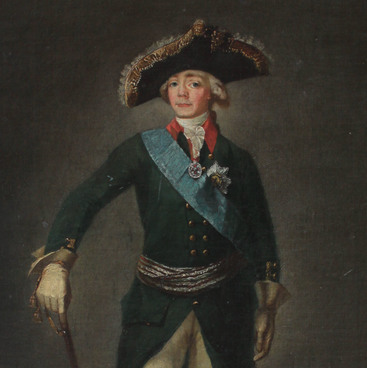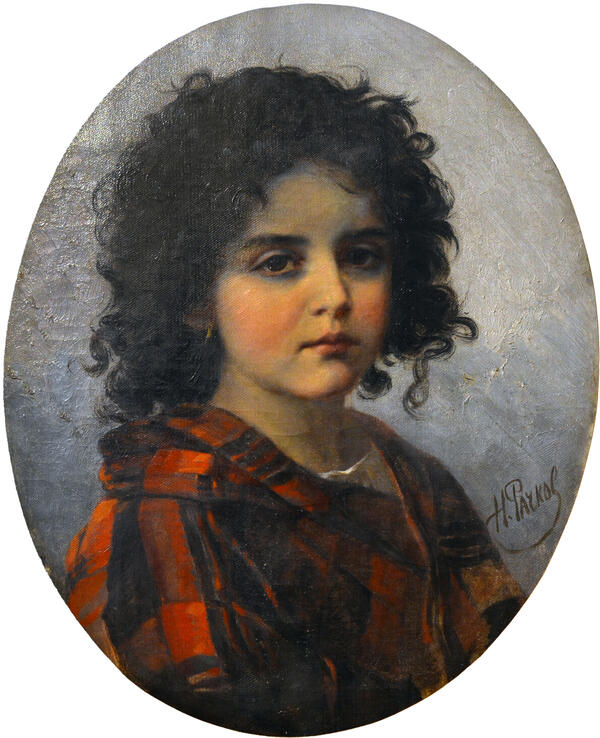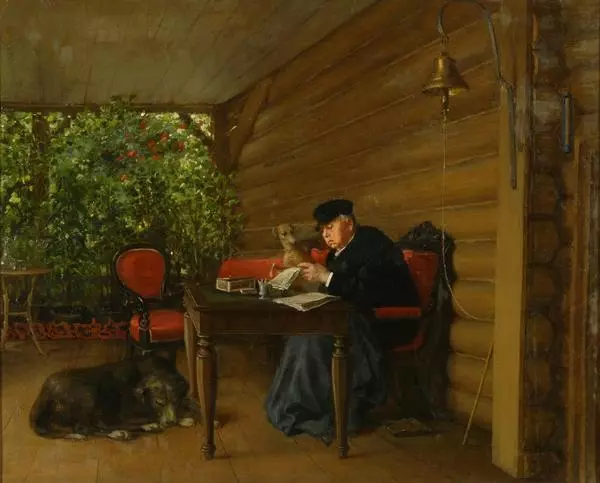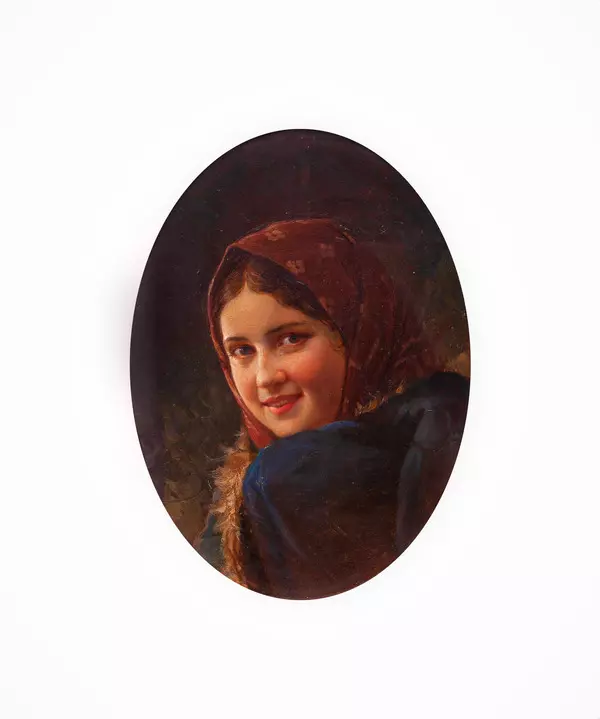The Delivery Boy, a small work by Russian artist Nikolai Rachkov was painted in 1880. Today it is reposited in the Stavropol Krai Museum of Fine Arts.
The Delivery Boy is painted light, the brush strokes are pastose and relief. Experts regard this painting as both staged – the character is clearly posing, and as a domestic scene typical of that time. A boy of 10–12 is depicted in the painting, dressed like a grown man — a man’s long-waisted coat over an untucked shirt, trousers tucked into boots. He is resting his elbow on the wall and sliding a large brown light peaked cap with his hand. A larksome and kind look reveals the child’s age and his lively nature. Next to the hero on a low table there is a tray with fruit covered with napkins.
Nikolai Rachkov often painted genre scenes and portraits in which he paid much attention to the ethnographic component of the personality and the nature of the person he was painting. Elliptical chest-high portraits by him of children and young ladies were particularly popular. The artist poeticized the everyday life and character type of the people, which pushed him closer to the Venetian artists. Genre scenes small in size brought his manner closer to the Lesser Dutchmen artists of the 17th century, who painted small domestic scenes, still-lifes, interiors and landscapes.
Rachkov received a systematic artistic education. His first advisor in painting was his father who was a teacher of drawing, then Rachkov studied at the Arzamas School of Painting under Alexander Stupin, a painter, and then at the Imperial Academy of Arts. In 1845 he became a free-lance portrait painting artist.
The scenes Rachkov observed became sketches with elements of plein-air painting technique which means painting objects in natural light and natural conditions. Serious art collectors bought his works, such as: Pavel Tretyakov, book publisher Kozma Soldatenkov, Isadzhan Isadzhanov.
Gradually, Rachkov’s range of works expanded — apart from paintings, he created illustrations, caricatures, satirical drawings. Rachkov introduced a lot of domestic stuff into his work, and it made him one of the brightest representatives of the genre art of the 19th century. His simple scenes and small portraits were popular with a wide range of art lovers.
The Delivery Boy is painted light, the brush strokes are pastose and relief. Experts regard this painting as both staged – the character is clearly posing, and as a domestic scene typical of that time. A boy of 10–12 is depicted in the painting, dressed like a grown man — a man’s long-waisted coat over an untucked shirt, trousers tucked into boots. He is resting his elbow on the wall and sliding a large brown light peaked cap with his hand. A larksome and kind look reveals the child’s age and his lively nature. Next to the hero on a low table there is a tray with fruit covered with napkins.
Nikolai Rachkov often painted genre scenes and portraits in which he paid much attention to the ethnographic component of the personality and the nature of the person he was painting. Elliptical chest-high portraits by him of children and young ladies were particularly popular. The artist poeticized the everyday life and character type of the people, which pushed him closer to the Venetian artists. Genre scenes small in size brought his manner closer to the Lesser Dutchmen artists of the 17th century, who painted small domestic scenes, still-lifes, interiors and landscapes.
Rachkov received a systematic artistic education. His first advisor in painting was his father who was a teacher of drawing, then Rachkov studied at the Arzamas School of Painting under Alexander Stupin, a painter, and then at the Imperial Academy of Arts. In 1845 he became a free-lance portrait painting artist.
The scenes Rachkov observed became sketches with elements of plein-air painting technique which means painting objects in natural light and natural conditions. Serious art collectors bought his works, such as: Pavel Tretyakov, book publisher Kozma Soldatenkov, Isadzhan Isadzhanov.
Gradually, Rachkov’s range of works expanded — apart from paintings, he created illustrations, caricatures, satirical drawings. Rachkov introduced a lot of domestic stuff into his work, and it made him one of the brightest representatives of the genre art of the 19th century. His simple scenes and small portraits were popular with a wide range of art lovers.








